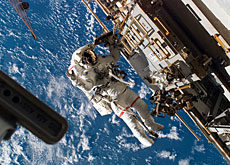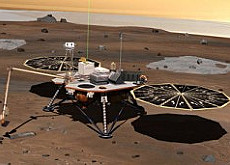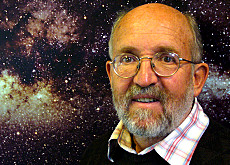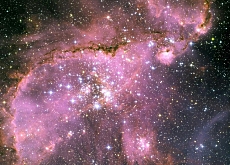Swiss scientist on a mission to clean up space

Fifty years of space activity have left a huge field of rubbish above our heads: rocket stages, satellite fragments, paint flakes – even an astronaut's glove.
Professor Thomas Schildknecht of Bern University’s Astronomical Institute is involved in monitoring the skies in a bid to resolve the growing space junk problem.
There are thought to be more than 600,000 pieces of rubbish of one centimetre or bigger zipping around our planet at thousands of kilometres per hour.
Space junk has become a growing concern in recent years, as collisions at orbital velocities could have catastrophic consequences for satellites, astronauts and spacecraft, and could also cause a domino effect, resulting in even greater amounts of debris.
At lower orbits (below 2,000km), a centimetre-sized speck of debris speeding along at 15 kilometres per second that hits an operational satellite has damage potential similar to a grenade.
“If you talk about lower orbits, where you’ve got space stations and manned missions, the issue is quite serious. For the International Space Station, for example, people say there is a 50 per cent chance within the next ten years that the station gets seriously hit by space debris,” Schildknecht told swissinfo.
Nasa researchers say a critical space junk tipping point is approaching. Even without launching any additional spacecraft, the number of new fragments created by collisions will exceed the number falling back to Earth and burning up by 2055.
Tracking space litter
Clearing up the mess in space can therefore seem like a monumental task.
“Nowadays there is no feasible mid-term way of actively cleaning up space, with a vacuum cleaner or whatever,” Schildknecht said.
Most international efforts are therefore focused on preventing collisions by keeping track of larger debris, and avoiding creating more.
Using optical telescopes, over the past eight years the Swiss scientist and his team have been monitoring the skies from Bern and the Spanish island of Tenerife, in collaboration with the European Space Agency, building up an inventory of small debris shooting across the skies at high altitudes.
“We see strange types of debris: insulation blankets peeling off satellites, for example,” he said.
Their surveys are then used to help manoeuvre satellites through debris fields. Currently every one or two months a satellite is moved out of the path of floating space junk.
Raining debris!
Another part of the team’s work involves making the space community more aware of how serious the environmental problem really is.
“It’s like waste management here on Earth. We come across waste dumped 15 years ago which people didn’t know about,” the researcher said.
According to Schildknecht, there is growing awareness among the space agencies, which have started to force commercial operators to stick to minimum guidelines. The ultimate goal is to come up with a code of conduct to limit the amount of debris created by space missions.
At certain altitudes – 800-1,000km – the problem is getting worse, he said, as there are lots of satellites and over time they may shed debris.
Most of this will gradually rain down and will end up in lower altitudes before entering the atmosphere.
“The major part of the problem is not the risk to Earth but to space missions themselves,” he said.
But Lottie Williams from Tulsa, Oklahoma, probably wouldn’t agree with Schildknecht.
Williams is on record as the first – and only – person to be hit by man-made space debris. On January 22, 1997, while walking in a park in Tulsa, she was hit on the shoulder by a 15cm piece of metal later confirmed to be part of the fuel tank of a Delta II rocket which had launched a US air force satellite in 1996. Fortunately Williams was not injured.
swissinfo, Simon Bradley
The US Space Surveillance Network monitors around 12,000 pieces of debris larger than ten centimetres. But the majority of debris objects remain unobserved.
According to a European Space Agency (ESA) model, there are more than 600,000 objects larger than 1cm in orbit. Information on space debris is collected by US, Russian and European radar and optical systems and used to validate models of the debris environment.
In collaboration with the ESA, Bern University’s Astronomical Institute has been tracking space junk and carrying out space debris surveys over the past eight years.
The five-person Swiss team uses optical telescopes located in Tenerife and at Zimmerwald, near Bern, to search for and monitor junk found mostly at high altitudes – 20,000-36,000km.
Space junk, or space debris, is any artificial rubbish orbiting the Earth. It consists of: jettisoned spacecraft parts, nuts and bolts, solar cells, abandoned satellites, paint chips, nuclear reactor cores, spent rocket stages and solid fuel fragments.
Hundreds of thousands of pieces of space junk are currently orbiting the Earth. However, all but 12,000 of these are smaller than a tennis ball.
This debris silently zips around the globe at speeds of up to 35,000km/h with altitudes ranging from hundreds to thousands of kilometres. At this speed, collisions, even with small pieces of junk, can be dramatic.
Explosions or collisions blast the objects into smaller pieces, increasing the number of objects further. Historically, the creation rate of debris has outpaced the removal rate, leading to a net growth in the debris population in low Earth orbit at an average rate of approximately five per cent per year.
The first confirmed collision with a satellite came in 1996, when a piece of drifting junk knocked the boom off the French satellite Cerise.
Current measures to improve the space junk problem include: the passivation of spent rocket stages by the release of residual fuels; taking satellites out of orbit at the end of their operational life; putting satellites in a graveyard orbit where no operational satellites are present.

In compliance with the JTI standards
More: SWI swissinfo.ch certified by the Journalism Trust Initiative




You can find an overview of ongoing debates with our journalists here. Please join us!
If you want to start a conversation about a topic raised in this article or want to report factual errors, email us at english@swissinfo.ch.